Day and night for months and months, people in my home village worked hard to turn farmland into a fancy Balinese compound. During the day, people built a pavilion using palms for the poles and bamboo for the floors. At night, people prepared bamboo decorations that would be used in the following days. All this dedicated work is not to welcome important figures nor to construct a community hall, but for the dead.
Yes, that’s right. The compound that takes three months to build is used in preparation to cremate dead bodies, a ceremony known as Ngaben in Bali, Indonesia.
The Balinese cremation ceremony or Ngaben is the Balinese Hindu funeral ritual to send the atma (soul) of the deceased to the alam pitra (atma’s world). Depending on the karma (the sum of a person’s actions) during their life, the soul will go through hell or heaven before they are reborn into another form in the next life. Or if they did good deeds and follow Hindu teaching during their life, the atma might reunite with God and avoid cycles of life. This reunion is known as moksha, and it is the ultimate goal of Hindu people.
Sometimes in Bali, bodies are cremated just a few days or weeks after they die. More often, the body is buried soon after death and then months or years later, dug up for cremation.
I use the term “the cremation ceremony” to refer to the whole process, from the beginning to the end of the cremation, which consists of a series of rituals. The number and the scales of ceremonies are slightly different from one place to another. In Balinese Hinduism, there are three different scales of the ceremony: nista (small), madya (average), and utama (big). People can choose any scale depending on their economic circumstances or just preference. Castes also play a role in various rituals of cremation. For example, a priest who belongs to the Brahmana caste is cremated differently from the sudtras (commoners).
The cremation ceremony that I share here is for my grandfather who passed away three years ago. He was cremated among fifteen other relatives belonging to an ancestral clan called dadia. In my dadia, we have a tradition to do a cremation ceremony every ten years. Because this ceremony happens infrequently, it is treated very specially and on a big scale.
Core Principles of the Cremation Ceremony in Bali
In Hinduism, we believe that the human consists of the physical body and the soul. Our physical body is formed by the Panca Maha Butha (the five physical elements): space, air, fire, water, and earth. When we die, our physical body is dead, but our soul is still alive. The purpose of the cremation ceremony is to separate the physical body and the soul. By burning the corpse, the person’s five physical elements will go back to the universe, and the soul can begin its next journey depending on their karma.
The series of rituals
Before the ceremony
The cremation ceremony is expensive and labor intensive, so the preparation needs to begin months earlier. The cost and labor required depends on the kind of cremation ceremony. A mass ceremony organized by a village or local government will not be as expensive for individual families. However, there is a consensus among Balinese people, or at least in my dadia, that the bigger the ceremony, the better for our ancestors.
In a small dadia like mine, we don’t have a space to conduct the ceremony, so we borrow space from dadia members. In this case, we used my grandfather’s land. The buildings are not made to be permanent because they will later be destroyed.
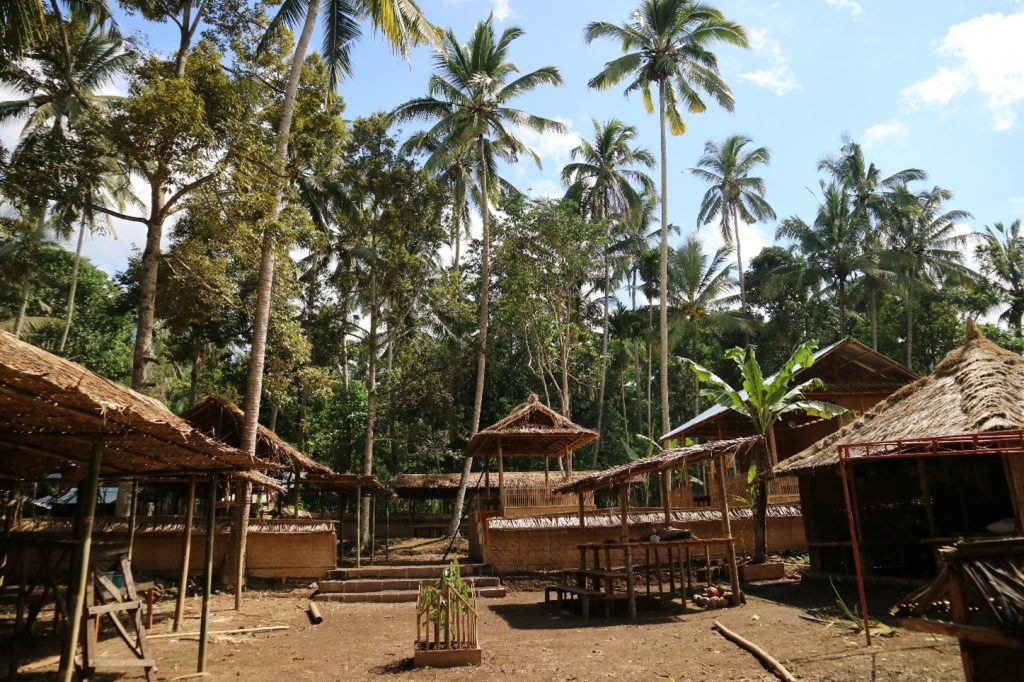
The rituals
● Ngebet (Exhuming the buried corpse)
Ngebet is the ritual to dig up the buried deceased and bathe them. The bathing ritual is the same as when the deceased had just passed away. In fact, the cremation ceremony is best done right after the person has died, but this is not always possible due to the expensive cost or some other reasons.
During the bathing process, symbolic items are used to reconstruct the corpses’ body parts. For example, pieces of glass for the eyes, neem leaves for eyebrows, and pieces of iron for teeth. These symbols are used to spiritually return the functions of body parts so when the deceased is reborn, they have complete body parts.
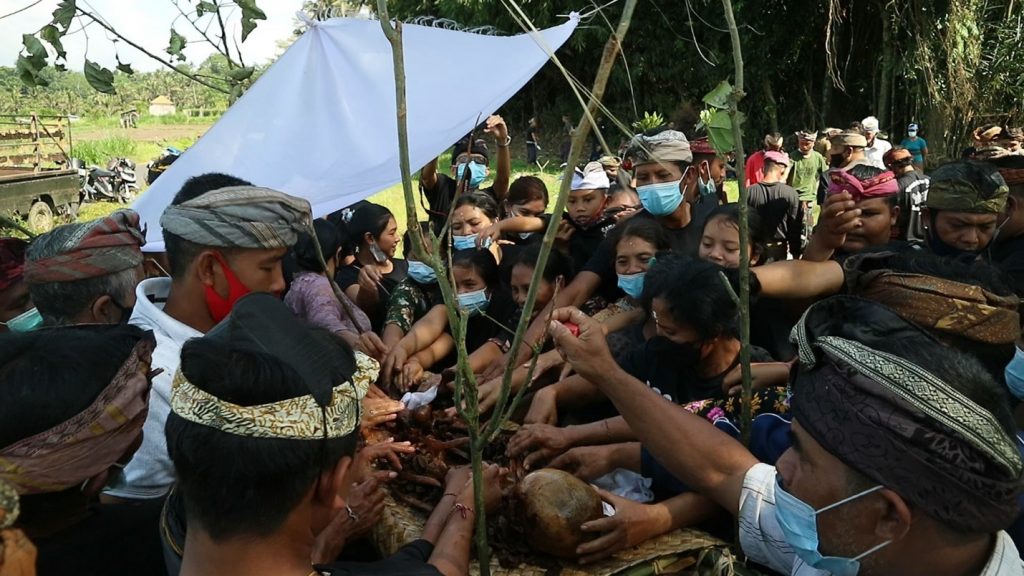
The deceased then are wrapped in pandanus matts and put into a pavilion ready to be burned. Some of the ashes will be collected and assembled, resembling human bodies. Each of these assemblies are wrapped with white cloth symbolizing purified physical bodies called rerakayaan.
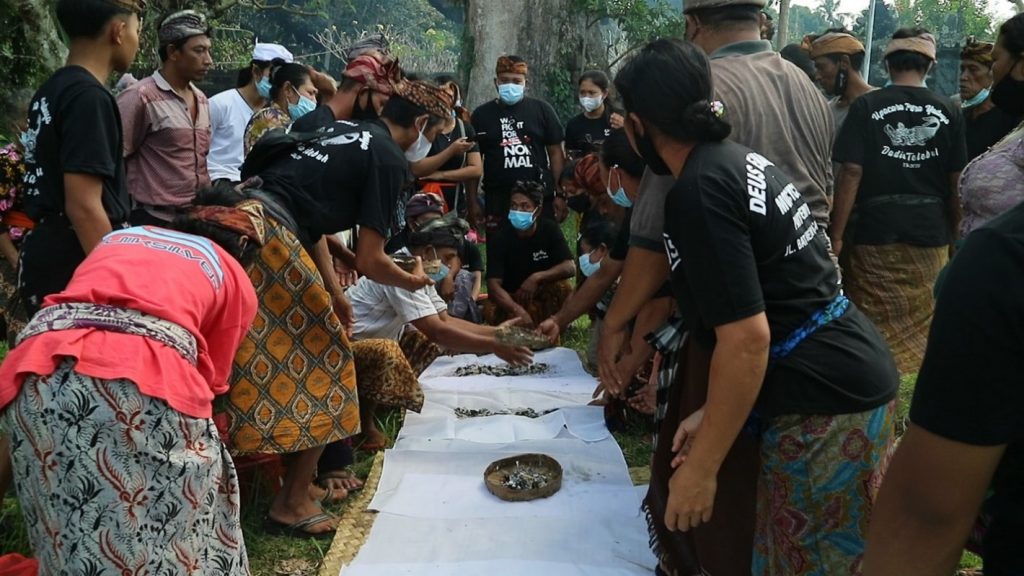
● Ngulapin (Calling the atma)
Before being cremated, atmas wander around in the human world so this ritual is aimed at summoning the atmas. This ritual is important, especially if people die outside of their houses, for example at the hospital.
This ritual began with praying in the cemetery temple of Siva (God of Death/Destruction). The point of this prayer is to ask permission to take the souls of the deceased for the cremation ceremony. Then, we will summon the atma in a designated crossroad.
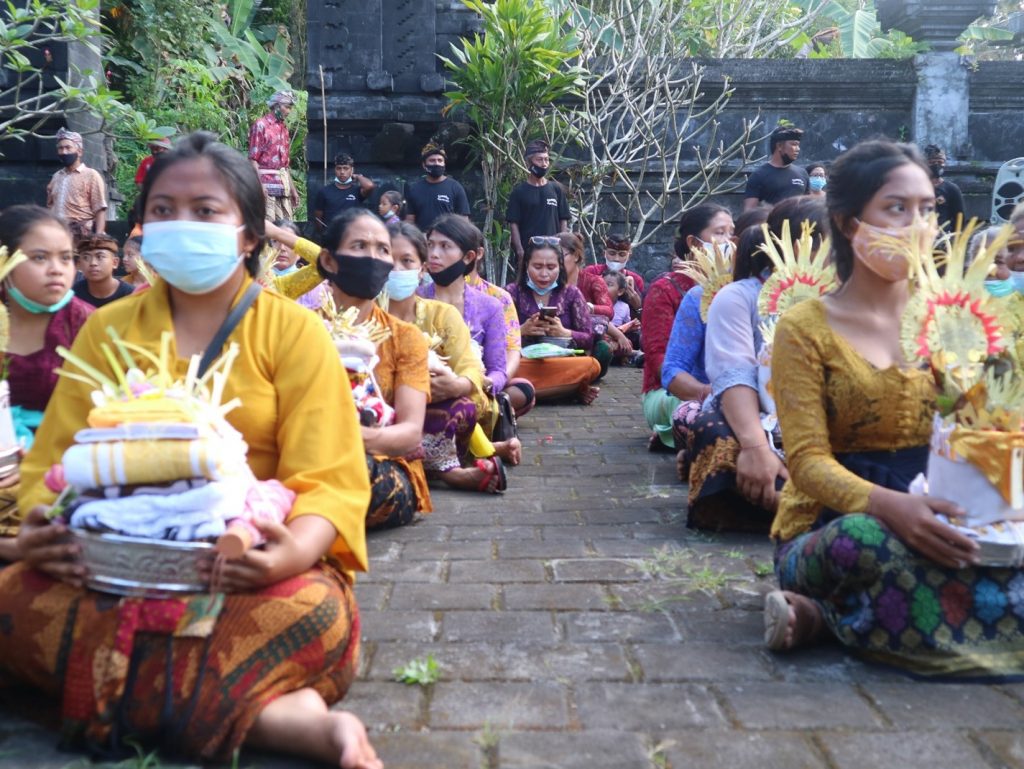
- Ngaskara Sang Pitra
In this ritual, the rerekayaans are bathed and purified, normally led by a priest. The purpose of this ritual is to prepare the deceased for their cremation ceremony which normally happens on the same day or on the next day.
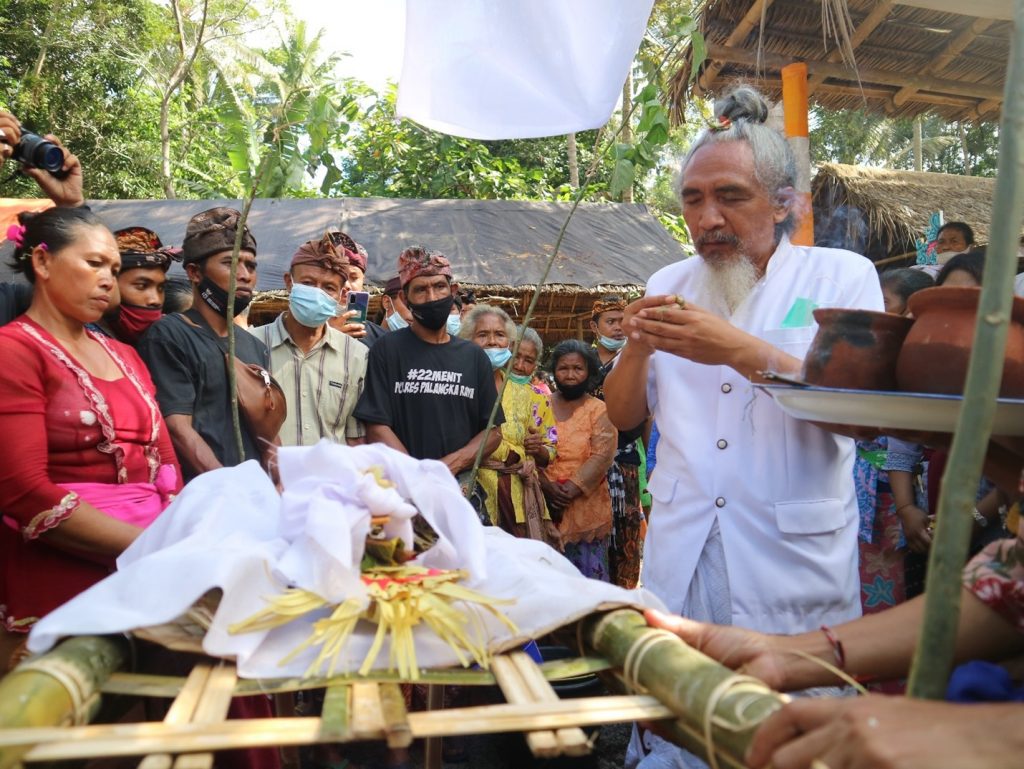
● Meras cucu (grandchildren prayers)
During this ritual, all grandchildren of the deceased pay respect to their grandparents in the hope that she/he will have a nice place in heaven.
● Pengabenan (cremation)
In this main ritual, the great and grandchildren of the deceased hold a long white cloth walking from the ceremonial place to the cemetery. They symbolically guide the deceased so they don’t get lost on the way to the cemetery where the cremation takes place.
Behind this white cloth troop, there are rerekayaan representing the deceased in tumpang salu, bed-shaped container made from bamboo; pengiriman, a temple-shaped container to carry deceased’s souls to the ocean, a gajah mina (a statue depicting a mix of elephant and fish), one of Hinduism’s mythical creatures that is believed to take the souls to the upper world of the supernatural beings; a baleganjur, Balinese traditional musical ensemble; and family members and relatives of the deceased.
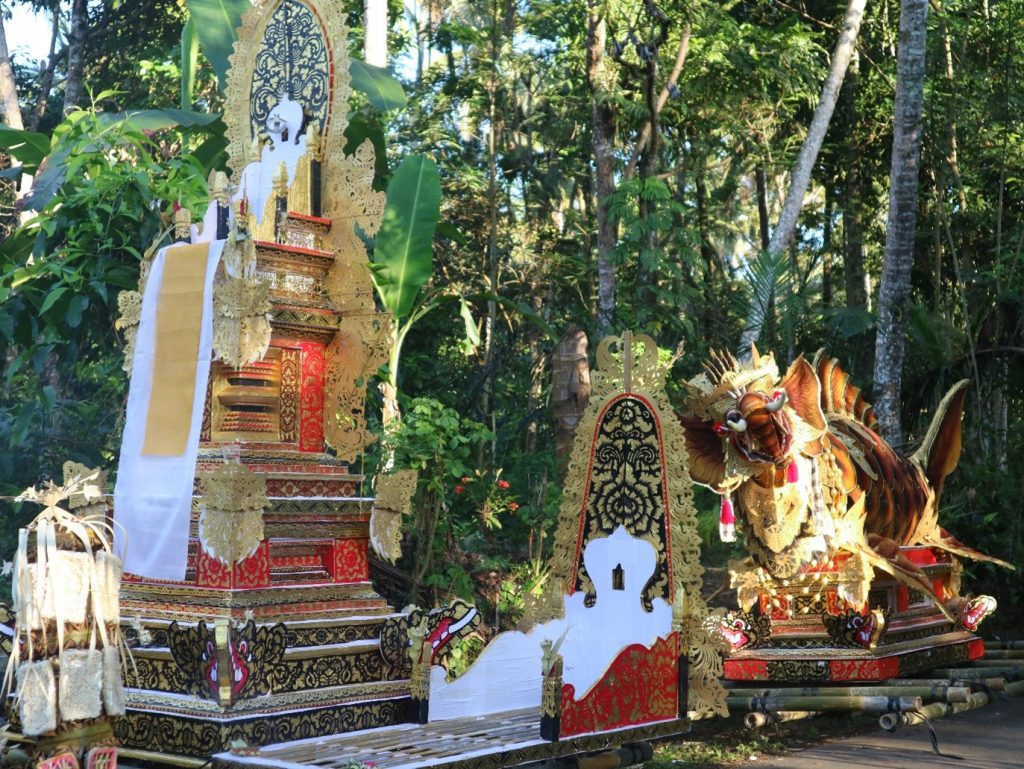
On the way to the cemetery, when a crossroad is met, everyone needs to go around three times symbolizing the deceased’s farewell to the environment.
When arriving at the cemetery, the white clothes are cut symbolizing the deceased’s farewell with their families.
After being prayed upon and blessed with holy water, rerekayaans are put inside the gajah mina and burned into flames. The ashes are then put in the pengiriman and driven to the ocean.
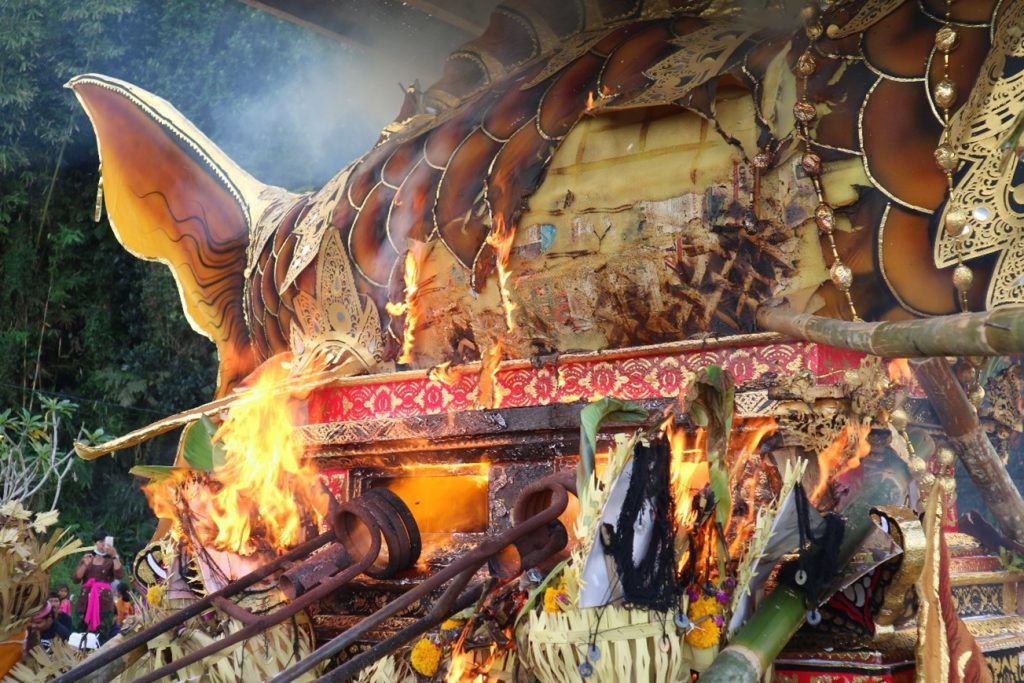
● Ngeroras (12 days ritual)
By now, the physical body of the deceased has returned to the universe and the souls have rested in the atma’s world. However, the souls haven’t been cleansed enough to reside in the house temple of their family. This is where Ngeroras comes in, a ceremony to summon the souls and repurify them so they can sit on the family’s temple to be worshiped.
The ceremony starts with a trip to the ocean to call the atma and take them to the ceremonial place. With the lead of a Balinese priest, the souls go through a purification ceremony. At the end, the souls will be guided back to the ocean for their return to their world.
● Nuntun (to guide)
This is the final step of the cremation ceremony. Similar to Ngeroras, this is another purification ritual for the souls so they can reside in the higher temple and the whole ancestral clan’s members can worship them.
The ritual began with summoning the souls in the ocean, then the families took them to the main temples in Bali. Finally, the soul is taken home and put in the designated temple.
With this last ritual, families of the deceased can feel relief. Their loved ones have united with other ancestors in the atma world. The families believe that their ancestors will come down to the earth when we have a ceremony in our clan’s temple. Until then, this is the families’ last tribute.
